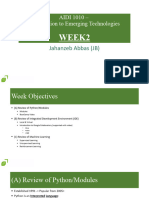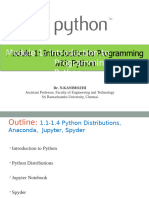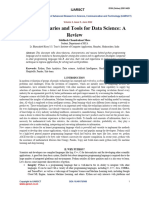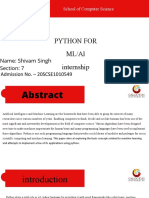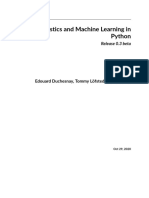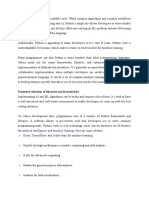Machine Learning in Python – Main Developments and Technology Trends in Data Science, ML, and AI
Uploaded by
wa7ieedMachine Learning in Python – Main Developments and Technology Trends in Data Science, ML, and AI
Uploaded by
wa7ieedIntroduction
Machine learning (ML) has revolutionized the way we analyze data and make decisions, and
Python is at the forefront of this transformation. This article provides an in-depth look at the
major developments in ML using Python, examining the trends that are driving progress in data
science, ML, and artificial intelligence.
Historical Context and the Rise of Python in ML
In the early days of machine learning, many projects were built using lower-level languages.
However, Python’s simplicity and versatility quickly made it a favorite among researchers and
developers. Its rich ecosystem—encompassing libraries such as NumPy, Pandas, and Matplotlib
—laid the groundwork for data analysis and visualization. As the demand for more sophisticated
ML models grew, Python’s role expanded with the introduction of frameworks like Scikit-learn,
TensorFlow, and PyTorch, which simplified the implementation of complex algorithms.
Current Developments and Trends
Several key trends are defining the current landscape of machine learning in Python:
Automated Machine Learning (AutoML): Tools that automate the selection and tuning
of ML models, reducing the time needed for model development.
Explainable AI (XAI): A growing focus on creating models that are not only powerful
but also transparent and understandable to humans.
Edge Computing: The push to bring ML models closer to data sources for faster
decision-making, with Python playing a central role in developing lightweight,
deployable models.
Integration of Big Data Technologies: Python is increasingly used alongside big data
platforms, enabling the processing of large datasets and real-time analytics.
Technological Trends and Innovations
The open-source nature of Python has spurred continuous innovation. Recent advancements
include:
Improved Frameworks: Continuous updates to TensorFlow, PyTorch, and emerging
libraries that enhance model performance and scalability.
Community-Driven Development: An active community that regularly contributes to
cutting-edge tools and best practices, ensuring that Python stays relevant in a rapidly
evolving field.
Hybrid Models: Combining traditional statistical methods with modern machine
learning techniques to address complex problems across diverse industries.
Implications for Data Science and AI
Python’s influence extends beyond technical advancements; it also shapes how organizations
approach data. By streamlining data preprocessing, model training, and deployment, Python
enables businesses to extract actionable insights from data more efficiently. This has led to
increased adoption of data-driven strategies across sectors such as healthcare, finance, and e-
commerce, where AI is driving competitive advantage.
Conclusion
Machine learning in Python is a dynamic field, continuously evolving as new trends and
technologies emerge. With its strong foundation, robust libraries, and an ever-growing
community, Python remains a cornerstone for ML, data science, and artificial intelligence. As
developers and researchers push the boundaries of what’s possible, Python will continue to serve
as the bridge between innovative theory and practical, impactful applications.
You might also like
- Anaconda's Guide To Open-Source: Tools and Libraries For Enterprise Data Science and Machine LearningNo ratings yetAnaconda's Guide To Open-Source: Tools and Libraries For Enterprise Data Science and Machine Learning29 pages
- Python and the AI Revolution A Comprehensive Deep Dive into Innovations, Challenges, and the Road AheadNo ratings yetPython and the AI Revolution A Comprehensive Deep Dive into Innovations, Challenges, and the Road Ahead6 pages
- Machine Learning in Python Main Developments and T100% (1)Machine Learning in Python Main Developments and T44 pages
- How Python is Shaping the Future of Artificial IntelligenceNo ratings yetHow Python is Shaping the Future of Artificial Intelligence1 page
- AIDI - 1010 - WEEK2 - Google Colab - v1.2No ratings yetAIDI - 1010 - WEEK2 - Google Colab - v1.217 pages
- Mastering Data Science with Python: The Ultimate Guide: Unlock the Power of Data Analysis and Visualization with Python's Cutting-Edge Tools and TechniquesFrom EverandMastering Data Science with Python: The Ultimate Guide: Unlock the Power of Data Analysis and Visualization with Python's Cutting-Edge Tools and TechniquesNo ratings yet
- Artificial_Intelligence_and_Machine_Learning_A_Beginners_GuideNo ratings yetArtificial_Intelligence_and_Machine_Learning_A_Beginners_Guide10 pages
- Slidesgo Harnessing The Power of Python For Artificial Intelligence 20240619082406mwcaNo ratings yetSlidesgo Harnessing The Power of Python For Artificial Intelligence 20240619082406mwca13 pages
- Artificial Intelligence with Python – A Practical GuideNo ratings yetArtificial Intelligence with Python – A Practical Guide2 pages
- Statistics Machine Learning Python DraftNo ratings yetStatistics Machine Learning Python Draft319 pages
- What Is Python?: Why Python For Data Science?No ratings yetWhat Is Python?: Why Python For Data Science?3 pages
- Python For Data Analysis The Python Crash Course Comprehensive The Programming From The Ground Up To Python by Cannon, JasonNo ratings yetPython For Data Analysis The Python Crash Course Comprehensive The Programming From The Ground Up To Python by Cannon, Jason167 pages
- School of Computer Science: Python For ML/Al InternshipNo ratings yetSchool of Computer Science: Python For ML/Al Internship12 pages
- PYTHON DATA ANALYTICS: Mastering Python for Effective Data Analysis and Visualization (2024 Beginner Guide)From EverandPYTHON DATA ANALYTICS: Mastering Python for Effective Data Analysis and Visualization (2024 Beginner Guide)No ratings yet
- Python - Follow Dr. AngShu (@drangshu) For More100% (1)Python - Follow Dr. AngShu (@drangshu) For More300 pages
- Python and AI – Transforming Healthcare, Finance, and BotsNo ratings yetPython and AI – Transforming Healthcare, Finance, and Bots2 pages
- Data Science With Python Workflow: Click The Links For DocumentationNo ratings yetData Science With Python Workflow: Click The Links For Documentation2 pages
- IoT Data Analytics using Python: Learn how to use Python to collect, analyze, and visualize IoT data (English Edition)From EverandIoT Data Analytics using Python: Learn how to use Python to collect, analyze, and visualize IoT data (English Edition)No ratings yet
- Activating Prior Knowledge To Raise Level of Scientific LiteracyNo ratings yetActivating Prior Knowledge To Raise Level of Scientific Literacy39 pages
- Qualitative Research Interviews-Is That What I Said - Interview Transcript Approval by ParticipantsNo ratings yetQualitative Research Interviews-Is That What I Said - Interview Transcript Approval by Participants28 pages
- History and Philosophy of Movement Education50% (2)History and Philosophy of Movement Education3 pages
- The Effect of Behavioral Accounting On Financial ReportingNo ratings yetThe Effect of Behavioral Accounting On Financial Reporting4 pages
- Assignment: 4: Relationship Between Leader Behaviors and Employees' Job Satisfaction: A Path-Goal ApproachNo ratings yetAssignment: 4: Relationship Between Leader Behaviors and Employees' Job Satisfaction: A Path-Goal Approach4 pages
- Lesson Plan - English Language and Social Studies - Grade 2 - Compare and Contrast Characters, Setting, and Events in A Written TextNo ratings yetLesson Plan - English Language and Social Studies - Grade 2 - Compare and Contrast Characters, Setting, and Events in A Written Text5 pages
- Lesson Plan #2: Collaboration: Grade: 1st Social Studies Strand: CivicsNo ratings yetLesson Plan #2: Collaboration: Grade: 1st Social Studies Strand: Civics4 pages
- A Lesson Plan in Analyzing Elements of Drama80% (5)A Lesson Plan in Analyzing Elements of Drama2 pages














